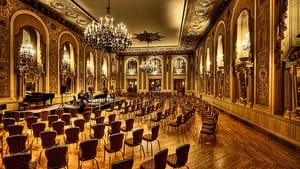Stay in the Loop
BSR publishes on a weekly schedule, with an email newsletter every Wednesday and Thursday morning. There’s no paywall, and subscribing is always free.
The gold standard
The Delaware Symphony Orchestra presents its Chamber Series with David Southorn and Lura Johnson

Traditionally, chamber music inhabited intimate-yet-grand spaces of rich or noble patrons. Modern chamber groups play in varied or even adventurous locales (eclectic public spaces, museums, large orchestra halls). These spaces aren’t always suited for this music, but a recent Delaware Symphony Orchestra (DSO) concert at Wilmington’s Hotel du Pont proved a welcome exception.
DSO’s chamber offerings are a treat, with the Hotel du Pont’s elegant Gold Ballroom housing this series. The opulent 1918 venue seems large but is actually a welcoming chamber venue. In spite of its ornament and drapery, the room has clear acoustics, due in large part to its expansive wood floor and unusual wall treatment. Adorned with what looks like period wallpaper or fabric, the walls are actually scenic panels in sgraffito — designs scratched into multiple layers of wet plaster — that give the room’s sound an unexpected warmth and clarity.
Beethoven and Britten
For four chamber concerts each year, maestro David Amado pulls orchestra players from their positions to showcase them, often sans conductor. Sometimes the evening focuses on a group of instruments — winds or percussion, for example. But the December 11 concert featured just two DSO members — David Southorn (violin) and Lura Johnson (piano).
Johnson and Southorn programmed three pieces with interesting connections and equally interesting differences. They opened with Beethoven’s Violin Sonata No. 8 (1803), filled with spirited arpeggios and melodies passing between piano and violin. Beethoven’s romantic fervor is evident in the first and third movements (allegro assai and allegro vivace), its dramatic unison runs and perpetual motion passages handled with ease and almost invisible communication.
The second movement — tempo di Minuetto — opens with a quasi-Austrian piano melody that gives way to dramatic rhythmic changes before returning with a reminder that it’s a minuet. The work was dedicated to Tsar Alexander I, and its opening and closing movements carry a hint of Slavic dance.
Next the duo played three movements from Benjamin Britten’s Suite for Violin and Piano Op. 6, a 1936 BBC Radio premiere. It’s a delicious work that cleverly offset the evening’s lush bookends. Britten was a viola player as well as a pianist, so the work has strong writing for both. The "March" movement is a witty, spiky section so short (about 2 minutes) that they played it twice. "Lullaby" opens with a dreamlike piano motif (played with crystalline clarity) that morphs into dreamy chord clusters and lyrical violin lines, capped with riveting pianissimo harmonics.

The suite ends with a "Waltz," and Britten deconstructs the form to make wry comments on its conventions even as he pays tribute. Programmatically, it was a treat to compare this to the waltz-like movement of the Beethoven.
A perfect pair
After intermission, Johnson and Southorn played César Franck’s magnificent Sonata in A Major for Violin and Piano (1886). It was a marriage gift for the violinist Eugène Ysaÿe, who first played it for his wedding guests. The work opens with a famous lyric string passage, soon underscored by majestic keyboard writing that contrasts with the violin’s passionate lyricism. Its four movements alternate between fast and slow, following one another swiftly and with little break between. The sections share common themes that cycle through the entire work, giving it dimension and weight. It’s a masterpiece, considered one of the finest works ever written for violin and piano, and the duo played it masterfully.
Johnson is a Steinway artist and Peabody teacher with an 11-recording discography. She is also a member of Duo Baltinari (second-prize winners in the chamber-music division of the 2015 International Brahms Competition). Southorn is concertmaster for DSO and several other orchestras. He was a recent member of the Chamber Music Society of Lincoln Center and part of the Amphion Quartet, whose 2015 album was selected by the New York Times as that year's Best Classical Album.
The two DSO colleagues appeared here in their first concert outing together. But they played with such grace and an easy sense of ensemble — meshing perfectly into a harmonious and well-balanced duo — that they seemed like longtime concert companions.
What, When, Where
Beethoven, Violin Sonata No. 8 (Op 3, No. 3); Benjamin Britten, Suite Op. 6 for Violin and Piano; César Franck, Sonata in A Major for Violin and Piano. Delaware Symphony Orchestra Chamber Series. December 11, 2018, at the Hotel du Pont, Wilmington, DE. (302) 656-7442 or delawaresymphony.org.
Sign up for our newsletter
All of the week's new articles, all in one place. Sign up for the free weekly BSR newsletters, and don't miss a conversation.

 Gail Obenreder
Gail Obenreder